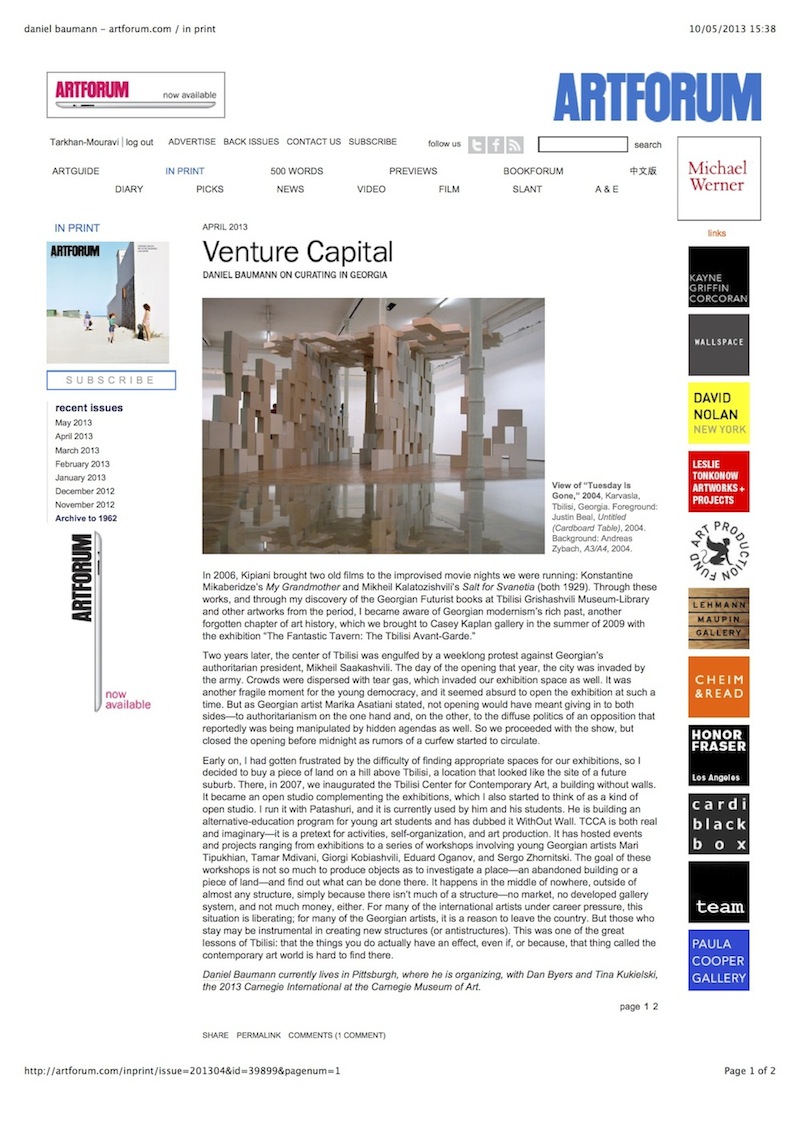Kote Sulaberidze belongs to the
generation of Georgian artists who have witnessed the Soviet and post-Soviet
Georgia and the transition between the two. This has included wars,
revolutions, economic crises and finally the first democratic elections. In
true Georgian nature, humor has become the critical self-defense mechanism for
him too. Meeting Mr. Sulaberidze, a chubby-looking man, there is not a single
negative vibe coming from him. Having been selected by the Sotheby's team for
the exhibition At the Crossroads, Kote
was honoured to attend the opening of the exposition. Very anxious of the
audience's response, he never left his canvas; while the spectator observed his
work he carefully inspected their faces trying to read the responses. Outside
the gallery space he is a very cheerful and easy-going person.
Baku Magazine, Spring 2013
Being notoriously color-blind, the artwork By Eyes of the Colour-blind, he presented on the exhibition is about
the condition- it is a mock color blindness test for the audience- if your
sight is in order you would notice the 13 on the adjoining canvases:
'I have been working around the theme since 1985 when I accidentally
discovered I was colorblind. When applying to the academy of arts, the
officials did not want to take me on board and claimed I were colorblind, so I
went and bought a doctor's note, but when I was told the same while applying
for driver's license I realized there was something wrong. My friend who is a
doctor confirmed that I had a condition. So I started reading the theory about
it and came to conclusion there is not much known about it. This painting is a
kind of experiment- I wanted to portray your vision based on theoretical
knowledge and at the same time I am giving you an opportunity to see through my
eyes. My wife has helped me a lot- I
cannot see the 13 that has to appear in the middle (between the two adjoining
canvases), so she had to correct it. Same about the 6- I see it vividly but my
wife says it is not there. This is a
prototype of the medical test that conditioned me with colour-blindness.'
His best work, however, has to be
the one rooted in the banal realities of everyday life in Georgia. With the
humor as an inseparable component to his art, Mr.Sulaberidze has created a
range of pseudoscientific sketches to portray the bittersweet living in
Georgia. Sketch 965, Khinkali
(Meat dumpling, a Georgian traditional dish) from the Travellers Series is one of the kind; drawn
on the graph paper, with all the measurements it does seem like an instructions
paper for a technical equipment; except that it is a drawing of a Khinkali, creating the
absurdity that may have engulfed the whole of Georgia. The multi-angled sketch
of the Khinkali ridicules the feeling of national pride that somehow came to be
entangled and inseparable from Khinkali. Famous Georgian poet Kote
Kubaneishvili has characterised the Georgian soul as the steam coming out of
Khinkali. Bespoke for hospitality, hosting a dinner for a foreign guest and giving
them a taste of Georgian cousine is an absolute 'must'- it came to be a
signifier of Georgian culture and ostensibly, the only thing Georgians are
proud of as part of their national identity. There is an apparent criticism of
the society in Sulaberidze's work that only cares about what to eat and drink, which is quite close
to the reality. Although denying having political
or social undercurrents as the focus of his art, Kote elaborates:
'Art should not be politicized, but politics is the part of our
everyday lives, so in a way it influences art. I would distinguish between
being politicized and having political content. When I painted Shevardnade (the
former President of Georgia) for example, I had not conceived a politicized
piece of art, it might be seen like one but I had not planned it that way. I
have created the piece for the exhibition in Moscow, which was organised as a
united project of the Georgian and Russian ministries of Culture. Funnily enough
these works were sent to Moscow by a bus, which on its way started selling
products –potatoes and sunflower seeds.It as then when Russian media started employing the term- 'Person of Caucasian
identity’, which was not a pleasant tag for me as a Georgian or in fact any
Caucasian person. Also, it was the time of the Chechen Wars and as the art
works were travelling to Moscow I have decided to work around this concept. The
work might be social and not only political; every country's leader is initially
the citizen of the country as well as being an ordinary person. There are some
responsibilities that all of us share.'
With the exhibition At the
Crossroads: Contemporary Art from the Caucasus and Central Asia Sotheby's
tried to overview the region and grasp the political and economic changes these counties
have gone through but even more so, it was an attempt to summarize and analyze
the contemporary art scene of these nations. As Joanna Vickery writes in the
foreword to the catalogue: '[the] show aims to increase awareness of their work
and foster the emerging market for art from this fascinating yet widely
unexplored region'. Even though the results of the exhibition (as it was a
sale) have not been publicly announced, it already has created a promising
precedent for the cultures largely unknown to Europe.




.jpg)












